Marc Weidenbaum's Blog, page 237
May 12, 2020
Buddha Machine Variations No. 29 (Prescient Delay)
At some point during the Buddha Machine Variations series of exercises, it occurred to me that many people who might come across these videos probably haven’t ever actually heard the Buddha Machines themselves. As a result, I began, on occasion, to include the unadulterated sound of the source audio at some stage of a given piece, generally at the start of a recording, so that the contrast between, dare I say, raw and cooked would be more evident.
This piece, “Prescient Delay,” is built around three delays set at different rates. It opens with the unaltered sound of the Chan Fang model of the Buddha Machine (first released in 2010). Or at least what appears to be unaltered sound. In fact, the audio is being delayed a few seconds. This delay doesn’t affect the sound itself. What it does do is allow for other sounds to insert themselves as premonitions of the main line. The main line here is the second channel of the mixer (the yellow cable). The delays all occur in the ER-301 module, the one three in from the bottom left.
A copy of that unaltered source audio is being sent, separately, through a filter bank, one of my favorite tools, which siphons off distinct bands of the audio spectrum. One of those bands, the white cable, goes into the first channel of the mixer. It’s heard for the first time just shy of 40 seconds into the recording. The quality of this line is quieter, softer, than the main track, and because the main track is set on a delay, this little element is heard before it, giving it a kind of prescience. This line is the only one in the piece occurring in sync with the Buddha Machine itself.
Another band of the filter bank, the orange one, channel three in the mixer, is also being delayed a tad, a bit less so than the main line, so when it is potted up, around the 1:20 mark, it contributes a second premonition of the main line.
Finally, a third band of the filter bank, the blue one (channel four in the mixer), is also set on a delay that’s shorter than the main line. It’s a third premonition, but it’s something else as well. While the delay of the yellow and orange lines are fixed, the delay of this blue band is shuddering, changing slightly, hence that warble quality it has. (The effect is a bit like that of the Instant Lo Fi Junky, a synthesizer module and guitar pedal that I like very much.) This is achieved thanks to a wave form that is ever so slightly altering the value of the delay (the number of milliseconds it is removed from the source audio). The wave is produced by a combination of two waves that come out of the Batumi (note the two short white cables) and go into the S.P.O., the white cable from which goes into the third gate jack of the ER-301. At 2:20, I push a button on the Ornament and Crime module (the black one three in from the bottom right), and you can see a little oscilloscope image. That image shows the wave form that is affecting the value of the delay for the blue line. In addition, if you look at the top screen of the ER-301, you might notice the value of the delay shifting up and down rapidly just above the fourth button in from the left.
And that covers it. If you have any questions, let me know. I’m very happy with how the premonition-like quality of these early apparitions function, and how they alter my sense of the utility of delays. I previously thought of delays as things that happen “after” the main line. No longer.
For further patch-documentation purposes, here’s a straight-on shot of the synthesizer:
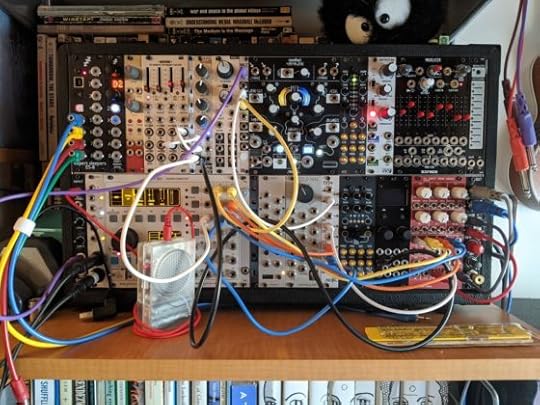
Video originally posted at youtube.com/disquiet. There’s also a video playlist of the Buddha Machine Variations.
Not Entirely a Coincidence
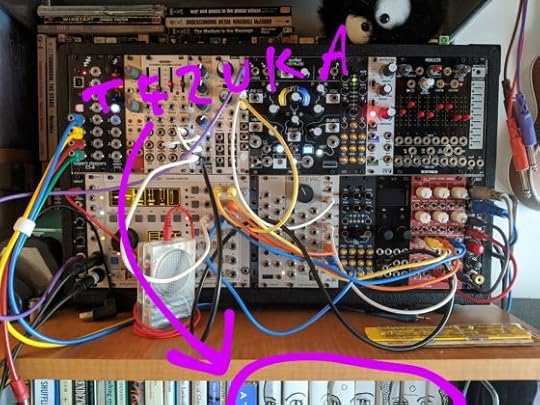
It was just last night that I noticed that my copies of Osamu Tezuka’s Buddha manga are on the shelf directly below where I’m recording the Buddha Machine Variations.
May 11, 2020
Buddha Machine Variations No. 28 (Qin Whopper)
So, to cut to the chase, there’s a big whopping error in the middle of this video. Actually, earlier than the middle. At 1:32 (the full length is 4:37), I connect a cable, and then proceed, over the following minute and a half, to 3:10, to first recognize something is off, and to then sort it out. I had the whole thing plotted, but it had been a long day and I was pretty tired, and I messed it up when I started recording. Still, that minute and a half sounds fine, and even as I was sleuthing what was wrong, I was thinking, “This actually sounds fine, so long as I can fix it soon.” As further evidence I was a bit rushed, the Buddha Machine that is the source of the sound is entirely off-screen. It’s the Chan Fang model, which is all samples of a performance on a qin, an ancient Chinese zither.
Three days/patches ago I mentioned parenthetically, of the big module in the lower left: “Of course, there’s a lot going on inside the ER-301 that’s not viewable.” If you watch that module from 1:32 to 3:10, you’ll get a sense of what moving around its interface is like.
Let’s break the recording down. There are four channels in the mixer, from left to right: one/lavender, two/black, three/yellow, and four/white. They are all variations on the incoming Buddha Machine loop.
Lavender is just the sound of the Buddha Machine loop, unaltered (putting aside the extent to which slight changes in the gain on the initial input do have an influence on the sound). Black and yellow are processed by the ER-301. Both are variations on bands of the incoming audio split off from the overall audio spectrum. Black is on a short delay, so it echoes a bit of the main signal (listen at 1:04 to how it repeats what just preceded it, as if a full register lower).
Yellow is the problematic channel. It is on a two-second loop that is constantly writing over itself when triggered. The signal that triggers the loop is itself fairly long, so the yellow signal doesn’t change that much. The problem was, it’s set in the ER-301 to be triggered by the gate on the top row, and I had it set on the second row. Eventually I figure this out, which is why at 3:10 I change the location of that cable, and at 3:16 the looping kicks in.
As for white, the fourth and final channel in the mixer, it is another band of the audio spectrum, sent through a granular synthesizer. And that covers it.
For further patch-documentation purposes, here’s a straight-on shot of the synthesizer:
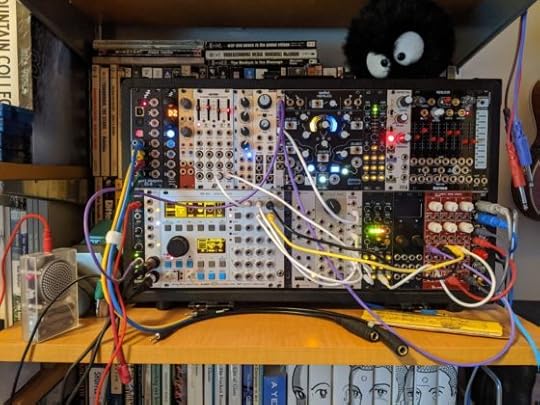
Video originally posted at youtube.com/disquiet. There’s also a video playlist of the Buddha Machine Variations.
May 10, 2020
Current Listens: Dub Eno + Fripp Soundscape
This is my answer to the question “What have you been listening to lately?” It’s lightly annotated because I don’t like re-posting material without providing some context. In the interest of conversation, let me know what you’re listening to in the comments below. Just please don’t promote your own work (or that of your label/client). This isn’t the right venue. (Just use email.)
▰ ▰ ▰ ▰ ▰ ▰ ▰ ▰ ▰ ▰ ▰ ▰ ▰ ▰ ▰
NEW: Recent(ish) arrivals and pre-releases
▰ Listen as the rapid arpeggios are contrasted with a flowing, emotional through line. The upcoming Hélène Vogelsinger album, Contemplation, doesn’t come out until June 12, on the Modularfield record label, but the lead track, “Astral Projection,” has been up for awhile now.
Contemplation by Hélène Vogelsinger
▰ This field recording is something I’ve played on repeat for hours at a time. Listen as the echo of test sirens in Boulder, Colorado, “seem to play sustained chords for a few minutes,” as Alan Bland, who made the recording, describes it.
▰ The three tracks on Ghost Signs’ The Holy Ghost and Other Lost Souls explore dense drones, at once heavenly and simmering. Highly recommended if that description appeals to you. It came out a month ago today, and has been a frequent listen.
The Holy Ghost and Other Lost Souls by Ghost Signs
▰ Music for Airports in Dub goes back to the start of 2020. Thomas Park took stems from the classic Brian Eno album Music for Airports and, using his own generative software, written in the language Python, created dub from them.
▰ The second of what promise to be 50 free streaming “ambient instrumental soundscape” tracks from Robert Fripp went live on May 8. It dates from 2009.
▰ ▰ ▰ ▰ ▰ ▰ ▰ ▰ ▰ ▰ ▰ ▰ ▰ ▰ ▰
ARCHIVAL: Old(er(ish)) records top mind
▰ The shifting wave forms of Éliange Radigue’s Trilogie de la Mort, released in 1998, were my frequent companion on public transportation. Now that, like much of the world, I’m stuck in the quiet of home, they’re becoming all the more vibrant to me.
Buddha Machine Variations No. 27 (Fracture Delay)
One loop, three strands, many rhythms. A single loop comes out of the second-generation Buddha Machine. It’s split into two. One cable goes straight into the mixer. That’s what’s heard when the first pot is turned up. The second cable goes into a filter bank, two cables from which go into the ER-301. Each carries a different band of the audio spectrum of the source loop. Each of those goes through a different delay in the ER-301, and then the volume of each of those fluctuates (using the ER-301’s Linear Unipolar VCA unit) due to waves coming from the Batumi. The ADDAC mixer has three options for each channel: solo, off, and mute. At the end, each of the three mixer channels is turned off one at a time.
For further patch-documentation purposes, here’s a straight-on shot of the synthesizer:
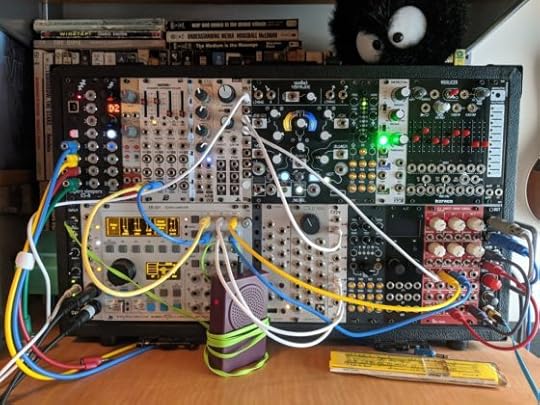
Video originally posted at youtube.com/disquiet. There’s also a video playlist of the Buddha Machine Variations.
Past Habits
It isn’t just that I’m not going out much at all. It’s how optimized my activities were, previously, for being out and about, something I was aware of but hadn’t thought about much until now, because now is now different enough from the past that the differences of the past have begun to come into focus.
Is that what we’re calling what amounts to just a few months ago? “The past”? I was calling it “The New Weirdness,” and then I shifted to “Slow Chaos.” But those felt too colorful, almost like celebrations, and there’s nothing to celebrate. Giving a colorful name to what’s going on feels like printing the photo of a serial killer. Not to lend agency to a phenomena, but a cool name feels like what it wants. Things have changed, and we put markers where changes occur so as to map the change. Markers, however, needn’t be celebratory. They can just be sticks in the road.
I’ve worked for myself for a decade, as of this coming July. That already meant working from home, at home, a lot. It also meant a significant amount of variability. I worked wherever I wanted (or needed) to be: at a cafe, at a museum, in a park, at someone else’s office, and frequently simply en route. “En route” isn’t merely a motion toward somewhere, but another kind of somewhere. I get a lot (excuse me: got a lot) done in public buses (my preferred and most frequent mode), in the occasional car (driving or being driven), planes (remember them?), and while walking. I am good (was good?) at related calculations: “I could drive there in X hours. If I take the train, it’ll be Xx2 hours, but I’ll get Y more done.” Also: “I have Y number of transit hours, so I’ll store up the documents I need to read until then.” Those particular skills haven’t found much utility in our unfortunate new present.
There were numerous resulting circumstances resulting from the variability and mobility I was accustomed to, most of which have evaporated: Certain types of music in certain travel conditions. Audiobooks and occasional phone calls on a drive I took once a week most weeks. A little MIDI device for use with my laptop as a productive distraction. A tidy backpack, the contents of which were adjusted as the years passed, that now sits in a closet, wondering what it did wrong. The three little cases for cables, pens, and such, now stacked on my desk, their contents dispersed. The MIDI device is available for when I want to make the long hike from the office … to the living room.
I’m used not just to walking, but to having a narrative in my ear as I go, lending a bit of fictional associative meaning to everyday instances, much as a movie soundtrack might. I’m used to certain albums that I only feel comfortable playing “that loud” in a car. I’m used to favorite drone albums merging with and blocking out the noises of public transportation.
None of that exists now. New habits are forming, some of which might even be good habits, but it’ll be some time before I can put a marker down and look back and understand them.
May 9, 2020
Buddha Machine Variations No. 26 (Chamber Buffer)
This reworking of a Buddha Machine loop is based on small, slowly accruing sub-loops (subsets of the source audio), much as was yesterday’s. There are some differences. The samples going into the buffers are more likely to cancel out the audio that preceded them, rather than build to an orchestral density (the change suits the source loop, from the fifth-generation Buddha Machine, which has a genteel, chamber-music quality). The sub-loops also each fade in and out, rather than cutting at the seam of each new sample. (Also, yesterday’s experiment used a different generation of Buddha Machine.)
When the video starts, all that’s heard is the loop itself, a combination of stately, simple piano and strings. At 26 seconds or so, a new element enters, not fully heard until about 38 seconds: it’s the source audio sliced and reworked courtesy of the Muxlicer. What’s going on is that as the audio comes through, there are eight potential ways we’ll hear it. Half of those are the audio, with the relative volume adjusted a bit (note the red faders above each of the eight jacks). Two are bands of audio extracted from the spectrum, courtesy of the FXDf module. And two are the left and right channels of the source audio going through a granular synthesizer. The pace of that Muxlicer is set by the pulse going through the lavender patch cable. The resulting Muxlicer activity goes into the first channel of the mixer (white cable).
At 1:13, a new element enters, the buffer looping. This is all happening in the ER-301 module (the Feedback Looper unit). What happens is that the source audio is being fed into a five-second loop, which itself is overwritten with small bits based on the pace set by a square wave from the Batumi (this goes into mixer channel two, yellow cable) . At 1:36, a second buffer loop enters, this one on a six-second loop (mixer channel three, blue cable). Eventually, around 3:18, the Muxlicer is turned down fully, so we only hear the contrasting buffered loops, until it all fades out.
For further patch-documentation purposes, here’s a straight-on shot of the synthesizer:
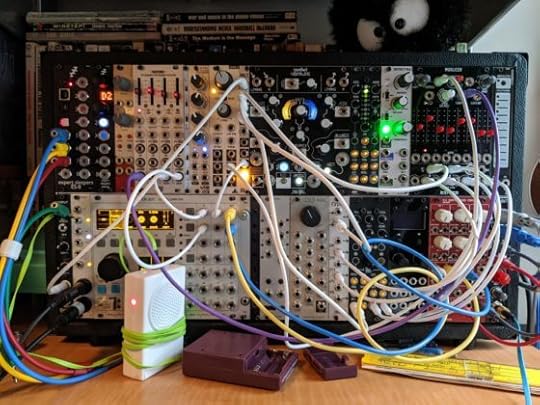
Video originally posted at youtube.com/disquiet. There’s also a video playlist of the Buddha Machine Variations.
This Week in Sound: Whispering Gallery
These sound-studies highlights of the week are lightly adapted from the May 4, 2020, issue of the free Disquiet.com weekly email newsletter This Week in Sound (tinyletter.com/disquiet).
As always, if you find sonic news of interest, please share it with me, and (except with the most widespread of news items) I’ll credit you should I mention it here.
▰ ▰ ▰ ▰ ▰ ▰ ▰ ▰ ▰ ▰ ▰ ▰ ▰ ▰ ▰
THIS WEEK IN SOUND
▰ “The role of a skilled medical transcriptionist is declining by the day as transcription documentation requires a lot of manual work, and more hospitals are gravitating towards a digital system, right from transcription (voice to text) to record-keeping (data lake or data warehouse).”
https://www.analyticsinsight.net/speech-recognition-seeing-sudden-spike-covid-19-pandemic/
▰ “It’s a perfectly valid concern, and my whole team had not thought of that ethical side of things.” That’s a Carnegie Mellon researcher commenting, per a piece by Aaron Holmes, on a project “building AI that would diagnose COVID-19 by listening to people talk.” The online portal for it was closed down in about 48 hours because it “could have run afoul of FDA guidelines and be misinterpreted by people regardless of the disclaimer.” (Via the hypervisible account on Twitter)
https://www.businessinsider.sg/ai-labs-diagnose-covid-19-voice-listening-talk-2020-4
▰ “An important consequence is that sound is always directed toward the future. Its future tense is so strong that sound is the sensory medium in which coming time is felt. That means in turn that sound is the sensory medium in which continuing life is felt. Although we commonly speak of looking into the future, in ordinary life what we really do is listen to the future arriving.” That’s Lawrence Kramer, author of The Hum of the World (2019), from an essay about listening lockdown.
https://thequietus.com/articles/28198-lawrence-kramer-covid19-essay
▰ “‘Audiophiles listen with their ears, not with their hearts,’ Hutchison said. He added: ‘That’s not our game, really.'” Ben Sisario profiles the vinyl craft of the London-based Electric Recording Co. “Mastering a vinyl record involves ‘cutting’ grooves into a lacquer disc, a dark art in which tiny adjustments can have a big effect. Unusually among engineers, Hutchison tends to master records at low volumes — sometimes even quieter than the originals — to bring out more of the natural feel of the instruments.” Quoted is Pete Hutchison, the company’s founder.
https://www.nytimes.com/2020/04/28/arts/music/electric-recording-co-vinyl.html
▰ “According to Waxy, Jay-Z’s company Roc Nation LLC filed copyright claims against two videos featured on the Vocal Synthesis YouTube channel. The company argued, ‘The content unlawfully uses an AI to impersonate our client’s voice.'” At issue, according to a report credited to waxy.org, are audio deepfakes.
https://screenrant.com/jay-z-youtube-audio-deepfake-debate/
▰ “I’ve heard speculation that when Stonehenge was complete in 2,200 BC, the outer sarsen circle might have behaved like a whispering gallery.” That’s Trevor Cox, who has capaciously documenting his sonic archeology of the famed spot. In the end, Cox finds “No evidence of whispering gallery waves in Stonehenge,” but the whole piece is worth a read to see (and hear) how he reached that conclusion.
https://acousticengineering.wordpress.com/2020/04/28/stonehenge-whispering-gallery/
▰ “The delineation itself didn’t recognize the way modern-day films create sound.” Chris O’Falt reports on the Oscars combining two awards, Best Sound Editing and Mixing, into one category: Best Sound.
https://www.indiewire.com/2020/04/best-sound-oscar-category-combining-mixing-editing-1202228175/
▰ ▰ ▰ ▰ ▰ ▰ ▰ ▰ ▰ ▰ ▰ ▰ ▰ ▰ ▰
GRACE NOTES
▰ I have fond memories of waking on a Saturday, getting dropped at the LIRR, taking the train to Penn Station, and walking to Greenwich Village, and then wandering around for hours buying records. But it was nice to buy things on Bandcamp this morning while drinking coffee.
▰ So much gestural data packed into a single fader: “Things like Position (with varying rates of slew), overall Activity rate, distance travelled, time between changes in direction, velocity (Distance/Time).” That’s Rodrigo Constanzo describing his experiment. Check out the video at
https://youtu.be/E3xQxD6_kvQ.
▰ The aesthetic of Fourth World music was envisioned by Jon Hassell as “unified primitive/futuristic.” That paradox sums up the sad state of healthcare, in that he must resort to internet-based crowdsourcing to help fund his medical expenses. Do give.
https://www.gofundme.com/f/jon-hassell-fund
▰ Last Wednesday in my sound course, Sounds of Brands (week 12), we were fortunate to have representatives of a microphone company talk about the organization, how they develop and sell equipment. My favorite takeaway phrase: “mic tastings” (events where professionals sample their wares).
▰ Stage 1: Modular synths are a great break from computers. Stage 2: [Spends hour updating firmware on modules by downloading files to laptop and connecting laptop to modules via USB cables or, alternately, moving SD cards back and forth.]
▰ Last night: I’m gonna work on using my synthesizer to recognize certain volume thresholds as triggers for other sounds. This morning: Vibrations and noise outside from street-repair crews at work are setting off car alarms around the immediate neighborhood.
▰ My personal experience remains: One doesn’t “dream of wires.” One is up late not sleeping (i.e., when one should be dreaming), and one is thinking of wires.
▰ Lee Tusman wrote a generous overview (“Learning Communities: Juntos, Woodsheds, Trainwrecks, Assemblies, Academies”) of online communities, including the Disquiet Junto. Here’s a brief excerpt: “I enjoy this creative making and learning community. It’s something that I enjoy being able to dive into or walk away from depending on how busy my life is. I like that when I want to engage, I can jump into the group and participate in a small way by making a short music track or listening to music or commenting on others’ work. When I want to be highly engaged because I have more time or a creative making prompt is really exciting to me I can jump in much more and participate in the online forums in discussion. It’s a creative group model that should be more widely imitated by creative practitioners.” Elsewhere in the essay, Tusman also writes about Glorious Trainwrecks, Navel’s Assemblies, and Babycastles Academy.
http://leetusman.com/nosebook/alt-ed/teaching/organizing/2020/05/02/juntos-assemblies-academies.html
▰ ▰ ▰ ▰ ▰ ▰ ▰ ▰ ▰ ▰ ▰ ▰ ▰ ▰ ▰
Subscribe to This Week in Sound at (tinyletter.com/disquiet).
May 8, 2020
Buddha Machine Variations No. 25 (Choir Gates)
A lot of these Buddha Machine Variations have been static/semi-generative things that just proceed under their own power. This is, I think, only the second where I intrude and do something to initiate changes.
The source audio is a loop of a Philip Glass choral piece emanating from the edition of the Buddha Machine created by FM3 to commemorate the minimalist composer’s 80th birthday.
The first time through, the loop is heard on its own. The second time through, beginning at about 30 seconds in, what’s heard is two treatments of the loop together, along with the original loop. You see me, during the pause, turn up two of the pots on the mixer, and turn down slightly the one that had been playing. The simpler of these two treatments is simply a narrow band of the audio, extracted from the spectrum.
The other treatment is a little more complex. It’s the Muxlicer (black module with eight vertical sliders in the upper right) clicking through at a steady pace. The module has eight output stages. There’s a main line, and then you can slot in alternates for any of the eight stages. When it’s first heard here, two are playing additional bands of the audio spectrum, which is why those moments stand out.
If you keep an eye on the horizontal lights across the Muxlicer, you can see a little red one pop on to show which channel is playing. The pace at which the lights change is steady. What is random is the sequence, as regulated by a sine wave (from the Dixie II module). It was interesting trying to find a pace that contributes the desired amount of randomness, when I was preparing the patch.
That’s the second time through. The third time through, again during the pause (at 60 seconds), I turn down the original line entirely, leaving just the two treatments that appeared in the previous round. The step-by-step pace is more prominent as a result.
Then I do two more things: I plug first one and then, at about 1:37, a second cable into the ER-301. That’s the large module with two screens in the lower left. What’s happening in the ER-301 is that the full audio of the original loop is, itself, being cut up and looped. There are two channels out of the ER-301 (this is using the Feedback Looper module). One is recording a four-second loop over and over, and the other a two-second loop. The recording of the loops isn’t in sync with the playing, so the snatches overlap haphazardly, piling overtones. If you were to watch the segments accrue, it’s a little bit like a fast motion audio version of posters being layered on the wall of a construction site.
For further patch-documentation purposes, here’s a straight-on shot of the synthesizer:
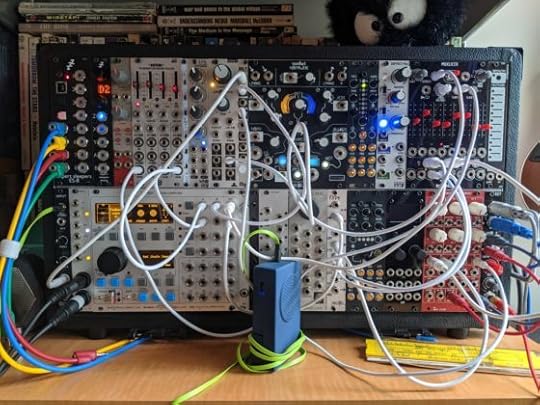
Video originally posted at youtube.com/disquiet. There’s also a video playlist of the Buddha Machine Variations.
May 7, 2020
Buddha Machine Variations No. 24 (Shudder Valve)
The goal here was to push the Muxlicer by altering its clock as time passes. The clock is what sets the pace of the changes that you hear. The Muxlicer, from the manufacturer Befaco, is the module toward the upper right corner. It’s the one with all those red faders that go up and down. The way the Muxlicer works (in this scenario, for there are various others) is you put in one master audio line that is then spread across the eight stages, the relative volume of which are individually set according to those faders. And then you can slot in alternate audio in as many of those eight stages as you like. So, as the clock clicks through its paces, you hear each of the eight stages in sequence, with the alternate audio occasionally replacing the main audio, and the volume of each stage shifting as well.
I’ll get to the source audio itself in a moment, but first about that clock situation. Initially while patching this, I just had a steady clock coming from a trigger pulse from the Dixie II (manufactured by Intellijel). If you want to know what the Muxlicer’s clock pulse is, keep an eye on the rate of the little light toward the top of the Dixie II, which is the seventh module in from the left on the top row. To give the steady pace some vibrancy, I had another wave, a sine from the Batumi (from the manufacturer Xaoc), create a random-ish, ever-shifting sequence as to which of the eight Muxlicer outs would play at any given moment. So far, so good.
But I wanted to push the clock further. This effort came in two phases of the patch’s development. The next thing I did was feed a slow moving square wave from the Batumi into the pitch control of the Dixie II. This meant every time the Batumi wave was on, the pitch of the Dixie II would suddenly level up, meaning the clock signal sent to the Muxlicer would speed up. This worked well, but an interesting thing happened. Since the square wave initiated this change in regular increments, going back and forth, the change in speed of the Muxlicer fairly quickly came to feel rote. If, as Brian Eno said, repetition is a form of change, then this was an example of how change (the clock going from fast to slow to fast, round and round) became a form of repetition. Something needed to change, in other words, for this to feel less repetitive. Something else needed to make that change occur.
I should note that the square wave going into the pitch of the Dixie II is squashed in height a bit by the S.P.O., from the company Steady State Fate. Initially this decision was made in order for the change in clock pacing to not be too significant. But then something occurred to me: the S.P.O. can combine signals, so I put a second, more chaotic wave also into the S.P.O., meaning that every once in a while, the square wave affecting the speed of the clock out of the Dixie II would itself be altered with a rapid little uptick. As a result, the change in the rhythm evidenced by the Muxlicer became more complex. If you keep an eye on the Muxlicer, there are eight horizontal red lights just below the faders. Watch those, and you’ll see how the clock changes. Where that additional, chaotic wave form comes from is it’s an envelope from the Detect-Rx, which is following the volume of one of the bands coming out of the filter bank. Which is to say, there’s some chaos going into the clock, but at some level it is correlated with the sound of a Buddha Machine itself
There’s more going on regarding the audio inputs. The blue one is first generation, and the peculiar color is second generation. The blue one (with the green audio cable) is split, and half the signal goes into a filter bank while the other half goes into a granular synthesizer. Three bands come out of the filter bank. One goes into the main Muxlicer in, one into an alt-in, and one into an envelope follower (more later). The left channel of the output of the granular synthesizer also goes into the Muxlicer alts (twice). The right channel of the granular synthesizer goes into a second channel of the mixer. Its volume is then altered thanks to a square wave coming out of the Batumi. However, I wanted to find a complement to the sudden jerks (the shudder) of the clock, so I put a burst-like signal into the trigger of the granular synth. The signal is a square wave, the frequency of which is being altered by a different square wave, the frequency of which is itself being altered by a sine wave (all within the Batumi; I believe this is referred to as self-patching). If you look at the lights of the four red faders of the Batumi (fourth module in from the upper left), you’ll see when that rapid burst kicks in. And, of course, you’ll hear it.
Which leaves a question: where’s the second-generation Buddha Machine? It’s not heard here. A patch starts in one place, and ends in another. At some point I disconnected the second Buddha , was pleased with the result, and never patched it back in. I didn’t fully recognize this until I was done.
For further patch-documentation purposes, here’s a straight-on shot of the synthesizer:
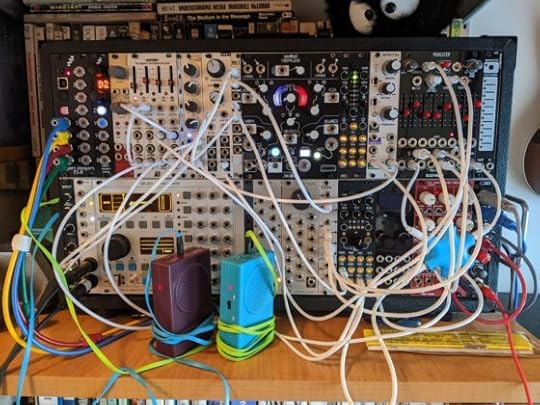
Video originally posted at youtube.com/disquiet. There’s also a video playlist of the Buddha Machine Variations.



